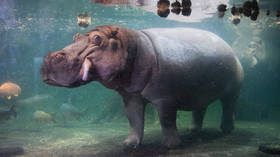Hippos can get airborne – study

Hippos, which weigh around 1.5 metric tons, are capable of getting airborne – but only for a very short period of time, scientists at the London-based Royal Veterinary College (RVC) have discovered.
They shared their findings in an article entitled “Footfall patterns and stride parameters of Common hippopotamus (Hippopotamus amphibius) on land,” published in the scientific journal PeerJ on Wednesday.
According to the paper, hippos can stay in the air for up to 0.3 seconds when running at full speed.
"Our most notable findings are that hippos normally trot (whether walking or running), and do use an aerial phase when running quickly,” the article said. Such a method of locomotion is not characteristic of other large land animals like elephants, rhinos or horses, it added.
The scientist came to the conclusion after analyzing videos showing 169 movement cycles from a total of 32 hippos, filmed in “extreme” situations such as trying to escape lions or rhinoceroses, or showing aggression toward each other, or humans and vehicles. The studied animals spent some 15% of each dash without touching the ground, the paper said.
"We were pleasantly surprised to see how hippos get airborne when they move quickly – it's really impressive!” John Hutchinson, the lead author of the study and a professor of evolutionary biomechanics at the RVC, told Sky News.
In a separate interview with CNN, Hutchinson described the discovery as “pretty neat” because hippos are “really hard to study” as they spend most of the time in the water, are more active at night, and are also “very aggressive and dangerous.”
Kieran Holliday, science and conservation officer at Flamingo Land Resort in Yorkshire, which provided videos of its two hippos to RVC researchers, stressed that the study “could have positive impacts on the wider zoo community in regards to husbandry and enclosure design.”
Hippos are the world’s second heaviest land creatures after elephants, according to the World Wildlife Fund (WWF). Despite their weight, they are capable of running at speeds of up to 30 km/h (19 mph) over short distances.
It’s estimated that between 115,000 and 300,000 hippopotamuses currently live in the wild, mainly in sub-Saharan Africa. The animals are herbivores, but are aggressive and extremely territorial. According to BBC Wildlife, hippos, which attack and capsize boats, are responsible for the deaths of some 500 people annually.













